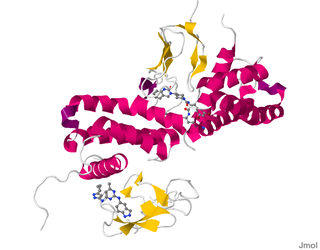
The KiSS1-derived peptide receptor is a G protein-coupled receptor which binds the peptide hormone kisspeptin (metastin). Kisspeptin is encoded by the metastasis suppressor gene KISS1, which is expressed in a variety of endocrine and gonadal tissues. Activation of the kisspeptin receptor is linked to the phospholipase C and inositol trisphosphate second messenger cascades inside the cell.

Death receptor 4 (DR4), also known as TRAIL receptor 1 (TRAILR1) and tumor necrosis factor receptor superfamily member 10A (TNFRSF10A), is a cell surface receptor of the TNF-receptor superfamily that binds TRAIL and mediates apoptosis.

Sodium-hydrogen antiporter 3 regulator 1 is a regulator of Sodium-hydrogen antiporter 3. It is encoded by the gene SLC9A3R1. It is also known as ERM Binding Protein 50 (EBP50) or Na+/H+ Exchanger Regulatory Factor (NHERF1). It is believed to interact via long-range allostery, involving significant protein dynamics.

Calcitonin receptor-like (CALCRL), also known as the calcitonin receptor-like receptor (CRLR), is a human protein; it is a receptor for calcitonin gene-related peptide.

Neuropeptides B/W receptor 1, also known as NPBW1 and GPR7, is a human protein encoded by the NPBWR1 gene. As implied by its name, it and related gene NPBW2 are transmembranes protein that bind Neuropeptide B (NPB) and Neuropeptide W (NPW), both proteins expressed strongly in parts of the brain that regulate stress and fear including the extended amygdala and stria terminalis. When originally discovered in 1995, these receptors had no known ligands and were called GPR7 and GPR8, but at least three groups in the early 2000s independently identified their endogenous ligands, triggering the name change in 2005.

Neuropeptides B/W receptor 2, also known as NPBW2, is a human protein encoded by the NPBWR2 gene.

Free fatty acid receptor 1 (FFA1), also known as GPR40, is a class A G-protein coupled receptor that in humans is encoded by the FFAR1 gene. It is strongly expressed in the cells of the pancreas and to a lesser extent in the brain. This membrane protein binds free fatty acids, acting as a nutrient sensor for regulating energy homeostasis.

Putative G-protein coupled receptor 42 is a protein that in humans is encoded by the GPR42P gene.

Free fatty acid receptor 2 (FFA2) is a G-protein coupled receptor encoded by the FFAR2 gene.

Neuropeptide FF receptor 2, also known as NPFF2 is a human protein encoded by the NPFFR2 gene.

Hydroxycarboxylic acid receptor 1 (HCA1), formerly known as G protein-coupled receptor 81 (GPR81), is a protein that in humans is encoded by the HCAR1 gene. HCA1, like the other hydroxycarboxylic acid receptors HCA2 and HCA3, is a Gi/o-coupled G protein-coupled receptor (GPCR). The primary endogenous agonist of HCA1 is lactic acid (and its conjugate base, lactate).

2-Oxoglutarate receptor 1 (OXGR1), also known as cysteinyl leukotriene receptor E (CysLTE) and GPR99, is a protein that in humans is encoded by the OXGR1 gene. The Gene has recently been nominated as a receptor not only for 2-oxogluterate but also for the three cysteinyl leukotrienes (CysLTs), particularly leukotriene E4 (LTE4) and to far lesser extents LTC4 and LTE4. Recent studies implicate GPR99 as a cellular receptor which is activated by LTE4 thereby causing these cells to contribute to mediating various allergic and hypersensitivity responses.

C5a anaphylatoxin chemotactic receptor 2 is a protein that in humans is encoded by the C5AR2 gene. It's a complement component G protein-coupled receptor, of class A (rhodopsin-like).

Relaxin/insulin-like family peptide receptor 3, also known as RXFP3, is a human G-protein coupled receptor.

Lysophosphatidic acid receptor 5 also known as LPA5 is a protein that in humans is encoded by the LPAR5 gene. LPA5 is a G protein-coupled receptor that binds the lipid signaling molecule lysophosphatidic acid (LPA).

Relaxin/insulin-like family peptide receptor 4, also known as RXFP4, is a human G-protein coupled receptor.

Neuromedin-U receptor 1 is a protein that in humans is encoded by the NMUR1 gene.

Relaxin/insulin-like family peptide receptor 2, also known as RXFP2, is a human G-protein coupled receptor.

NPW is a gene that in humans encodes Neuropeptide W protein.

RF(Arg-Phe)amide family 26 amino acid peptide, also known as P518, is a human protein.
















